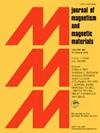Strain detection based on magnetic domain wall motion in amorphous FeSiBNb thin film
IF 2.5
3区 材料科学
Q3 MATERIALS SCIENCE, MULTIDISCIPLINARY
引用次数: 0
Abstract
The strain dependence of the pulse voltage induced in a pickup coil originating from the domain wall motion in an amorphous FeSiBNb thin film was investigated. No significant change in the peak pulse voltage was observed when tensile strain was applied to the thin film, whereas the peak pulse voltage changed steeply when compressive strain was applied. In addition, strain susceptibility could be controlled via appropriate annealing. Evaluation of the strain gauge comprising the amorphous FeSiBNb thin film, a pickup coil, an electrical circuit (which converts the pulse voltage into direct current voltage), and a Helmholtz coil revealed that strain gauge has a notably high gauge factor of approximately 37,500.
基于非晶态 FeSiBNb 薄膜磁畴壁运动的应变检测
研究了非晶铁硅铌薄膜中的畴壁运动在拾波线圈中引起的脉冲电压的应变依赖性。在薄膜上施加拉伸应变时,峰值脉冲电压没有明显变化,而施加压缩应变时,峰值脉冲电压会发生急剧变化。此外,还可以通过适当的退火来控制应变敏感性。应变计由非晶态 FeSiBNb 薄膜、拾取线圈、电路(将脉冲电压转换为直流电压)和亥姆霍兹线圈组成,对应变计进行评估后发现,应变计的量规系数高达 37,500 左右。
本文章由计算机程序翻译,如有差异,请以英文原文为准。
求助全文
约1分钟内获得全文
求助全文
来源期刊

Journal of Magnetism and Magnetic Materials
物理-材料科学:综合
CiteScore
5.30
自引率
11.10%
发文量
1149
审稿时长
59 days
期刊介绍:
The Journal of Magnetism and Magnetic Materials provides an important forum for the disclosure and discussion of original contributions covering the whole spectrum of topics, from basic magnetism to the technology and applications of magnetic materials. The journal encourages greater interaction between the basic and applied sub-disciplines of magnetism with comprehensive review articles, in addition to full-length contributions. In addition, other categories of contributions are welcome, including Critical Focused issues, Current Perspectives and Outreach to the General Public.
Main Categories:
Full-length articles:
Technically original research documents that report results of value to the communities that comprise the journal audience. The link between chemical, structural and microstructural properties on the one hand and magnetic properties on the other hand are encouraged.
In addition to general topics covering all areas of magnetism and magnetic materials, the full-length articles also include three sub-sections, focusing on Nanomagnetism, Spintronics and Applications.
The sub-section on Nanomagnetism contains articles on magnetic nanoparticles, nanowires, thin films, 2D materials and other nanoscale magnetic materials and their applications.
The sub-section on Spintronics contains articles on magnetoresistance, magnetoimpedance, magneto-optical phenomena, Micro-Electro-Mechanical Systems (MEMS), and other topics related to spin current control and magneto-transport phenomena. The sub-section on Applications display papers that focus on applications of magnetic materials. The applications need to show a connection to magnetism.
Review articles:
Review articles organize, clarify, and summarize existing major works in the areas covered by the Journal and provide comprehensive citations to the full spectrum of relevant literature.
 求助内容:
求助内容: 应助结果提醒方式:
应助结果提醒方式:


